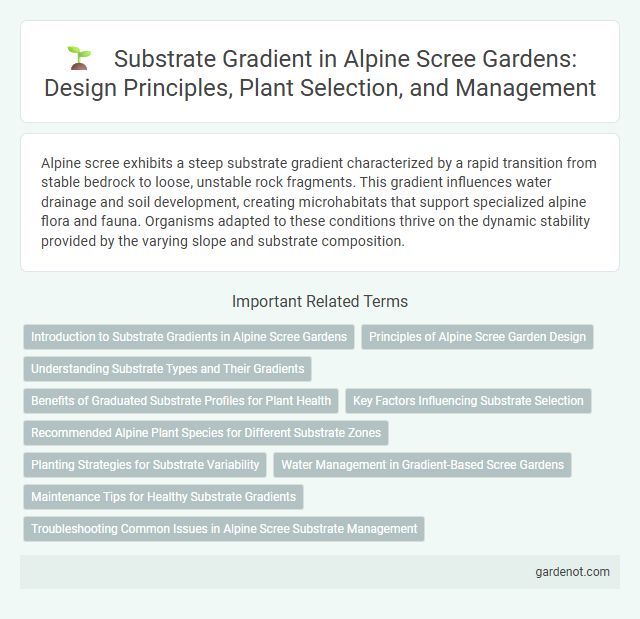Alpine scree exhibits a steep substrate gradient characterized by a rapid transition from stable bedrock to loose, unstable rock fragments. This gradient influences water drainage and soil development, creating microhabitats that support specialized alpine flora and fauna. Organisms adapted to these conditions thrive on the dynamic stability provided by the varying slope and substrate composition.
Introduction to Substrate Gradients in Alpine Scree Gardens
Substrate gradients in Alpine scree gardens refer to the variation in soil composition and particle size from coarse, rocky material at higher points to finer, more organic-rich substrates lower down. This gradient influences water retention, aeration, and nutrient availability, crucial for the survival of specialized alpine plants adapted to harsh conditions. Understanding substrate gradients enables gardeners to replicate natural alpine environments, promoting plant health and biodiversity in cultivated scree beds.
Principles of Alpine Scree Garden Design
Alpine scree garden design emphasizes a carefully managed substrate gradient to mimic natural mountain habitats, ensuring optimal drainage and root aeration for alpine plants. The gradient typically transitions from coarse, well-draining gravel at the surface to finer mineral particles deeper down, replicating natural scree stability and moisture retention. This layered substrate supports specialized alpine flora by balancing water availability and preventing root rot in harsh, high-altitude conditions.
Understanding Substrate Types and Their Gradients
Substrate gradients in alpine scree habitats vary from coarse, unstable rock fragments to finer, more stable sediments, influencing vegetation patterns and soil development. Understanding the distribution of substrate types, such as talus slopes composed of angular rock debris versus mixed scree with finer mineral particles, reveals how gradient steepness and particle size affect water retention and root penetration. Detailed analysis of these gradients aids ecologists in predicting plant colonization dynamics and soil formation processes in high-altitude ecosystems.
Benefits of Graduated Substrate Profiles for Plant Health
Graduated substrate profiles in alpine scree create microhabitats with varied moisture retention and nutrient availability, enhancing root establishment and growth. These gradients support diverse plant species by providing optimal conditions for water drainage and aeration, reducing root rot risk and promoting resilience to environmental stress. Optimized substrate layering improves nutrient cycling efficiency, facilitating sustained plant health in harsh alpine environments.
Key Factors Influencing Substrate Selection
Substrate gradient plays a critical role in alpine scree ecosystems, influencing water drainage, nutrient availability, and microhabitat stability. Key factors shaping substrate selection include particle size distribution, mineral composition, and slope angle, which together determine the suitability for root anchorage and microbial colonization. Temperature fluctuations and freeze-thaw cycles further affect substrate integrity, driving species adaptation and community composition.
Recommended Alpine Plant Species for Different Substrate Zones
Alpine scree substrate gradients range from coarse, unstable rock fragments at higher elevations to finer, more consolidated materials at lower zones, influencing plant colonization patterns. Recommended alpine plant species for coarse upper scree include Saxifraga oppositifolia and Silene acaulis, which tolerate poor nutrient availability and frequent displacement. In lower, more stable substrate zones, species such as Dryas octopetala and Salix herbacea establish robust root systems adapted to slightly richer soils and increased moisture retention.
Planting Strategies for Substrate Variability
Planting strategies for alpine scree must address the substrate gradient characterized by varying particle sizes, moisture retention, and nutrient availability. Utilizing a mix of pioneer species and deep-rooting plants stabilizes loose substrate and promotes soil development along the steep gradient. Tailoring species selection to microhabitat conditions enhances survival rates and ecological succession in substrate-variable alpine scree environments.
Water Management in Gradient-Based Scree Gardens
Water management in gradient-based alpine scree gardens relies on substrate gradient to control drainage and moisture retention effectively. Steeper substrate gradients facilitate rapid water runoff, preventing waterlogging, while gentler slopes promote infiltration and sustain moisture for specialized scree vegetation. Optimizing the substrate gradient enhances water distribution, supporting plant adaptation and soil stability in alpine scree ecosystems.
Maintenance Tips for Healthy Substrate Gradients
Maintaining healthy substrate gradients in alpine scree involves careful monitoring of soil particle size distribution and moisture retention to prevent erosion and support native flora. Regularly aerate the substrate to enhance drainage and nutrient availability, ensuring the balance between coarse gravel and finer sediments promotes root stability. Employ erosion control techniques such as planting deep-rooted vegetation and using permeable barriers to maintain substrate integrity and prevent nutrient depletion.
Troubleshooting Common Issues in Alpine Scree Substrate Management
Managing substrate gradient in alpine scree requires monitoring soil composition to prevent uneven drainage and erosion, which can compromise plant stability. Ensuring a balanced mix of gravel, sand, and organic matter helps maintain optimal moisture levels and nutrient availability for hardy alpine species. Regular inspection and adjustment of substrate layers mitigate common problems such as substrate compaction and nutrient leaching, promoting healthy plant growth and ecosystem resilience.
Substrate gradient Infographic

 gardenot.com
gardenot.com